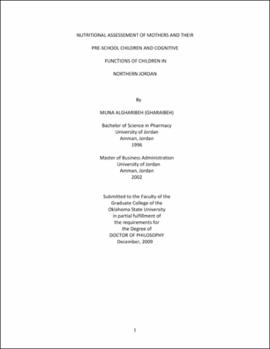| dc.contributor.advisor | Stoecker, Barbara J. | |
| dc.contributor.author | Gharaibeh, Muna Algharibeh | |
| dc.date.accessioned | 2013-11-26T08:26:18Z | |
| dc.date.available | 2013-11-26T08:26:18Z | |
| dc.date.issued | 2009-12 | |
| dc.identifier.uri | https://hdl.handle.net/11244/6859 | |
| dc.description.abstract | Scope and Method of Study: | |
| dc.description.abstract | Nutritional status of women of childbearing age and their preschool children was assessed in a cross-sectional study in summer 2007. A convenience sample of 93 women and their preschool children from urban/suburban areas in northern Jordan was recruited for the study with the help of local community centers. Anthropometric measurements were performed and information on socioeconomic status, health issues, lifestyle factors, and nutritional intakes were obtained from mothers by questionnaire. Serum 25(OH)D and intact serum PTH were measured using enzyme-linked immunoabsorbent assay (ELISA) kits. In addition to hemoglobin (Hb), the following were measured: plasma ferritin using immunoradiometric assay; transferrin receptor using enzyme linked immunoassay; alpha-1-acid glycoprotein using radial immunodiffusion, and plasma zinc using inductively coupled plasma mass spectrometry. Body iron (mg/kg) was quantitatively estimated. Cognitive function was assessed in children using components of the Peabody Picture Vocabulary Test-IV (PPVT-IV) and of the Kaufman Assessment Battery for Children (K-ABC-II). | |
| dc.description.abstract | Findings and Conclusions: | |
| dc.description.abstract | Mean age of women was 33.9 years and of children was 60.7 months. The mean +-SD for 25(OH) D was 25.6 +- 9.6 nmol/L in women and 55.8 +- 19.8 nmol/L in children. A total of 48.9% of women were below 25.0 nmol/L and 97.8% were below 50 nmol/L. Mothers with ferritin <15 microg/L were 54%, and 16% of children had ferritin <12 microg/L. Mothers had significantly lower mean serum ferritin and higher TfR (13.1 +- 3.1 microg/L, and 7.6 +- 1.5 mg/L, respectively) than their children (21.9 +- 2.0 microg/L, and 5.9 +- 1.4 mg/L, respectively). More than 50% of mothers and 30% of children had AGP>=1.2 g/L, and 77% of women were classified as overweight or obese with a BMI>=25kg/m2. Plasma zinc was 67.2 +- 11.4 microg/dL in mothers and 64.6 +- 9.4 microg/dL in children. More than half of mothers (58%) and children (56%) were below IZiNCG cutoffs for zinc deficiency. Three parameters: TfR, TfR/ferritin, and TfR/Log10 ferritin were evaluated using receiver operator characteristic (ROC) curves. TfR/ferritin and TfR/Log10ferritin had better diagnostic efficiency in detecting iron deficiency than the use of TfR alone. Cognitive function was assessed in children, and neither ferritin nor zinc predicted child performance on most of the tests. Co-existing micronutrient deficiencies (in terms of vitamin D, iron, and zinc) were widespread among mothers and children in northern Jordan. | |
| dc.format | application/pdf | |
| dc.language | en_US | |
| dc.rights | Copyright is held by the author who has granted the Oklahoma State University Library the non-exclusive right to share this material in its institutional repository. Contact Digital Library Services at lib-dls@okstate.edu or 405-744-9161 for the permission policy on the use, reproduction or distribution of this material. | |
| dc.title | Nutritional assessment of mothers and their pre-school children and cognitive functions of children in northern Jordan | |
| dc.contributor.committeeMember | Kennedy, Tay S. | |
| dc.contributor.committeeMember | Kuvibidila, Solo Ruth | |
| dc.contributor.committeeMember | Miller, Janice Williams | |
| osu.filename | Gharaibeh_okstate_0664D_10707 | |
| osu.accesstype | Open Access | |
| dc.type.genre | Dissertation | |
| dc.type.material | Text | |
| dc.subject.keywords | cognitive functions | |
| dc.subject.keywords | ferritin and transferrin receptor | |
| dc.subject.keywords | jordan | |
| dc.subject.keywords | vitamin d | |
| dc.subject.keywords | women of childbearing age | |
| dc.subject.keywords | zinc | |
| thesis.degree.discipline | Human Environmental Sciences (Option: Nutritional Sciences) | |
| thesis.degree.grantor | Oklahoma State University | |
